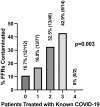N95® filtering facepiece respirator contamination with SARS-CoV-2 following reuse and extended use
- PMID: 40657985
- PMCID: PMC12483621
- DOI: 10.1017/ice.2025.92
N95® filtering facepiece respirator contamination with SARS-CoV-2 following reuse and extended use
Abstract
Objective: During the COVID-19 pandemic, the United States Centers for Disease Control and Prevention provided strategies, such as extended use and reuse, to preserve N95 filtering facepiece respirators (FFR). We aimed to assess the prevalence of N95 FFR contamination with SARS-CoV-2 among healthcare personnel (HCP) in the Emergency Department (ED).
Design: Real-world, prospective, multicenter cohort study. N95 FFR contamination (primary outcome) was measured by real-time quantitative polymerase chain reaction. Multiple logistic regression was used to assess factors associated with contamination.
Setting: Six academic medical centers.
Participants: ED HCP who practiced N95 FFR reuse and extended use during the COVID-19 pandemic between April 2021 and July 2022.
Primary exposure: Total number of COVID-19-positive patients treated.
Results: Two-hundred forty-five N95 FFRs were tested. Forty-four N95 FFRs (18.0%, 95% CI 13.4, 23.3) were contaminated with SARS-CoV-2 RNA. The number of patients seen with COVID-19 was associated with N95 FFR contamination (adjusted odds ratio, 2.3 [95% CI 1.5, 3.6]). Wearing either surgical masks or face shields over FFRs was not associated with FFR contamination, and FFR contamination prevalence was high when using these adjuncts [face shields: 25% (16/64), surgical masks: 22% (23/107)].
Conclusions: Exposure to patients with known COVID-19 was independently associated with N95 FFR contamination. Face shields and overlying surgical masks were not associated with N95 FFR contamination. N95 FFR reuse and extended use should be avoided due to the increased risk of contact exposure from contaminated FFRs.
Conflict of interest statement
Dr Wang reported having a contract with the Centers for Disease Control and Prevention (CDC) during the conduct of the study. Dr Degesys reported receiving grants from the CDC during the conduct of the study. Dr Rosenthal reported receiving grants from the CDC and the National Institute for Occupational Safety and Health (NIOSH) during the conduct of the study. Dr Yaffee reported receiving grants from the CDC during the conduct of the study. Dr Shah reported receiving grants from the CDC during the conduct of the study and from Omron and RPS outside the submitted work. No other disclosures were reported.
Figures
References
-
- NIOSH. NIOSH Guide to the Selection and Use of Particulate Respirators. https://www.cdc.gov/niosh/docs/96-101/default.html. Published 1996. Accessed April 09, 2023.
-
- CDC. Centers for Disease Control and Prevention. Summary for healthcare facilities: strategies for optimizing the supply of n95 respirators during shortages. https://www.jointcommission.org/-/media/tjc/documents/covid19/summary-st.... Published 2021. Accessed April 09, 2023.
-
- Emanuel EJ, Persad G, Upshur R, et al. Fair allocation of scarce medical resources in the time of covid-19. N Engl J Med 2020;382:2049–2055. - PubMed
-
- Ranney ML, Griffeth V, Jha AK. Critical supply shortages: the need for ventilators and personal protective equipment during the covid-19 pandemic. N Engl J Med 2020;382:e41. - PubMed
LinkOut - more resources
Full Text Sources
Miscellaneous


